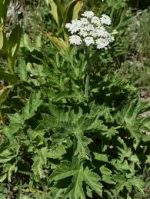 Cow parsnip is a herbacious biennial and a member of the parsley family, Apiaceae, that also includes celery, carrot, and Queen Anne’s lace. It is native to most of North America where it grows in woodlands, forest openings, grasslands, meadows, stream and river edges, wet ditches,and along roadsides. Plants have a tap root or thick cluster of roots and a stout, hallow, light green stem 4- 8′ tall. The stem has verticle ridges, is usually unbranched, and is covered with white hairs. The lower leaves are carried on petioles 3-10″ long, are up to 20″ across, and are divided into three oval coarsely-toothed, lobed leaflets, 4-12″ long. Upper leaves are up to 4″ long, have 3 lobes, and are coarsely toothed. Terminal flat-headed compound umbels up to 12″ across appear from late spring to mid summer during the second year. Each umbellete has 8-30 small white flowers 1/4″ across. Plants should be handled with care because the sap of the leaves and stems contain a phototoxin that reacts with ultraviolet light to cause skin irritations that can be severe and painful. The genus name, Heracleum, honors the mythological hero Hercules and refers to the large size of the plant and its parts. The specific epithet, maxium, is the Latin word meaning largest, and again refers to the size of the plant parts.
Cow parsnip is a herbacious biennial and a member of the parsley family, Apiaceae, that also includes celery, carrot, and Queen Anne’s lace. It is native to most of North America where it grows in woodlands, forest openings, grasslands, meadows, stream and river edges, wet ditches,and along roadsides. Plants have a tap root or thick cluster of roots and a stout, hallow, light green stem 4- 8′ tall. The stem has verticle ridges, is usually unbranched, and is covered with white hairs. The lower leaves are carried on petioles 3-10″ long, are up to 20″ across, and are divided into three oval coarsely-toothed, lobed leaflets, 4-12″ long. Upper leaves are up to 4″ long, have 3 lobes, and are coarsely toothed. Terminal flat-headed compound umbels up to 12″ across appear from late spring to mid summer during the second year. Each umbellete has 8-30 small white flowers 1/4″ across. Plants should be handled with care because the sap of the leaves and stems contain a phototoxin that reacts with ultraviolet light to cause skin irritations that can be severe and painful. The genus name, Heracleum, honors the mythological hero Hercules and refers to the large size of the plant and its parts. The specific epithet, maxium, is the Latin word meaning largest, and again refers to the size of the plant parts.
Type: Herbaceous biennial
Bloom: Small white flowers in compound umbels up to 12″ across from late spring to mid summer
Size: 4-8′ H
Light:Full sun to light shade
Soil: Fertile, consistently moist, well-drained
Hardiness: Zones 3-8
Care: Low maintenance
Pests and Diseases: None of significance
Propagation: Seed, division
Companion Plants: Angelica atropurpurea, northern bedstraw, Virginia waterleaf